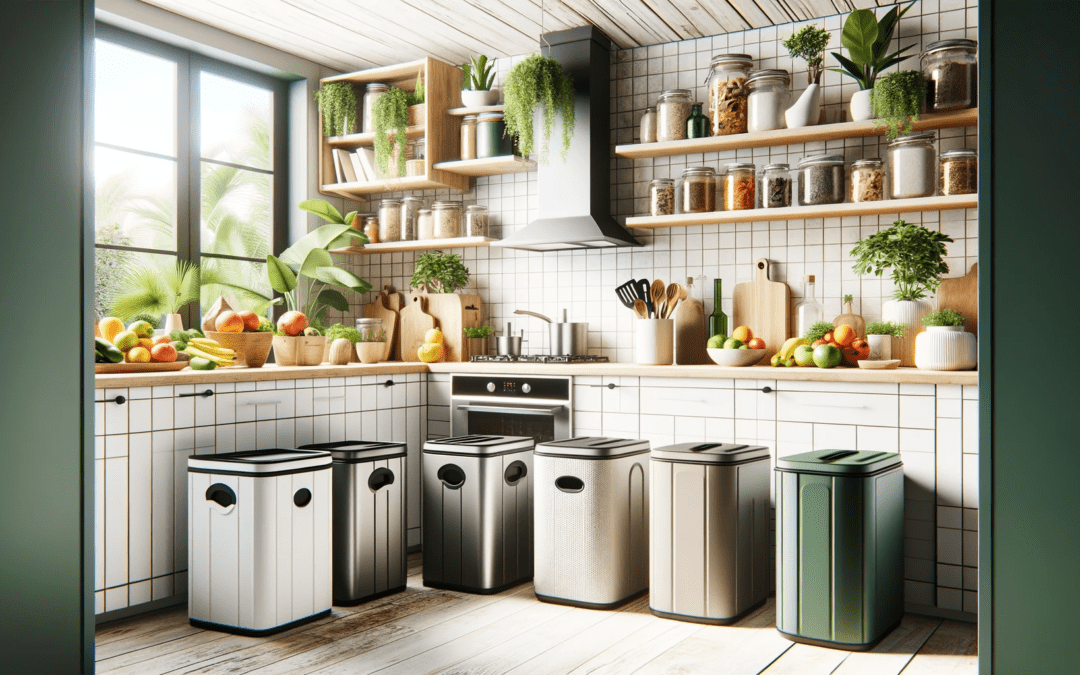In today’s eco-conscious world, indoor composting bins have become an essential part of a sustainable household. These bins allow you to conveniently compost kitchen waste, transforming scraps into nutrient-rich soil that can be used for gardening. The process not only reduces waste but also enriches the soil, promoting a healthier environment. When choosing the perfect indoor composting bin, it’s important to consider factors like capacity, odor control, design, and ease of use. This article presents the top ten indoor composting bins available, each carefully selected for its efficiency, design, and user-friendliness. Whether you live in a small apartment or a large house, there’s an option for everyone.
1. Epica Stainless Steel Compost Bin (Amazon)
- Key Features: 1.3-gallon capacity, stainless steel construction, charcoal filter, compact design
- Pros: Durable, odor-free, stylish, easy to clean, rust-resistant
- Cons: Limited capacity, may require frequent emptying, filters need replacement
- Description: The Epica Stainless Steel Compost Bin is perfect for those who value both functionality and style. Its sleek design complements any modern kitchen, and the stainless steel build ensures longevity. Despite its compact size, it can hold up to 1.3 gallons of compost material. The charcoal filter effectively traps and controls odors, making it ideal for indoor use. Easy to clean and rust-resistant, this bin is both practical and elegant, but may require frequent emptying if you generate a lot of kitchen waste.
2. OXO Good Grips Easy Clean Compost Bin (Amazon)
- Key Features: 0.75-gallon capacity, countertop design, flip-up lid, removable lid for easy emptying
- Pros: Compact, easy to use, convenient for daily waste, dishwasher safe
- Cons: Small size, frequent emptying needed, not suitable for larger households
- Description: OXO Good Grips Compost Bin is designed for convenience and ease of use. Its small size makes it ideal for placement on countertops, and the flip-up lid allows for quick disposal of waste. The removable lid makes emptying a breeze. It’s dishwasher safe, making cleaning simple. Although its 0.75-gallon capacity is on the smaller side, it’s perfect for individuals or small families who are new to composting.
3. Bamboozle Food Composter (Amazon)
- Key Features: Made from biodegradable bamboo fiber, 1-gallon capacity, dishwasher safe, includes carbon filter
- Pros: Eco-friendly material, odor control, easy to clean, visually appealing
- Cons: More fragile than metal, may require careful handling, limited capacity
- Description: The Bamboozle Food Composter stands out with its environmentally friendly material. Made from biodegradable bamboo fiber, it brings a natural aesthetic to your kitchen. The carbon filter helps control odors, and its 1-gallon capacity is sufficient for daily food scraps. The composter is dishwasher safe, ensuring hassle-free maintenance. However, being made from bamboo, it might require more careful handling compared to metal bins.
4. Full Circle Fresh Air Odor-Free Kitchen Compost Bin (Amazon)
- Key Features: Patented design, 1.5-gallon capacity, air circulation technology, multiple color options
- Pros: Controls odors naturally, large capacity, easy to clean, stylish design
- Cons: Plastic construction, larger footprint, requires compatible bags
- Description: This compost bin from Full Circle offers a unique combination of style and functionality. Its patented design allows for air circulation, minimizing odor without the need for filters. With a 1.5-gallon capacity, it’s suitable for families. The bin is easy to clean and comes in multiple colors to suit different kitchen decors. However, its plastic construction may not be as durable as metal options, and its larger size requires more counter or floor space. It’s designed to work best with compatible compostable bags, adding to its convenience but also to ongoing costs.
5. Chef’n EcoCrock Counter Compost Bin (Amazon)
- Key Features: 0.75-gallon capacity, ceramic construction, dual charcoal filters, modern design
- Pros: Aesthetically pleasing, effective odor control, sturdy, easy to clean
- Cons: Smaller capacity, ceramic can chip or break, higher price point
- Description: The Chef’n EcoCrock is a stylish addition to any kitchen, with its modern design and ceramic construction. The dual charcoal filters effectively control odors, and its 0.75-gallon capacity is perfect for small households. The bin is sturdy and easy to clean, although the ceramic material means it’s more prone to chipping or breaking if dropped. Its higher price point is a reflection of its quality and design appeal.
6. Utopia Kitchen Stainless Steel Compost Bin (Amazon)
- Key Features: 1.3-gallon capacity, stainless steel, charcoal filter, sturdy handle
- Pros: Durable, rust-resistant, controls odors, easy to transport
- Cons: Filters need regular replacement, plain design, may dent if dropped
- Description: Utopia Kitchen’s compost bin offers a practical and durable solution for indoor composting. Its stainless steel construction is rust-resistant and durable. The charcoal filter effectively controls odors, and the sturdy handle makes it easy to carry. While the design is somewhat basic, it’s functional and suits most kitchen styles. Regular replacement of the charcoal filter is needed for optimal performance, and the metal can dent if mishandled.
7. Exaco 2-in-1 Kitchen Countertop Compost Bin, 1 Gallon (Amazon)
- Key Features: 1-gallon capacity, 2-in-1 design for compost and storage, made of high-quality plastic, includes a charcoal filter
- Pros: Versatile with dual functionality, effective odor control, compact and convenient, easy to clean
- Cons: Plastic construction may not be as durable as metal, relatively small capacity, design might not suit all kitchens
- Description: The Exaco 2-in-1 Kitchen Countertop Compost Bin is a versatile addition to any kitchen. Its unique 2-in-1 design allows it to serve as both a compost bin and storage container, making it perfect for those with limited space. The bin, made of high-quality plastic, is designed to be compact and sits conveniently on any countertop. It comes equipped with a charcoal filter to control odors effectively, ensuring a pleasant kitchen environment. While the plastic construction offers ease of cleaning, it might not have the same durability as stainless steel options. Its 1-gallon capacity is ideal for small to medium-sized households, but larger families might find it necessary to empty it more frequently. The design is modern and functional, though it may not align with every kitchen’s aesthetic.
8. Sure-Close Kitchen Composter (Amazon)
- Key Features: 1.9-gallon capacity, lightweight design, vented lid, handle for easy carrying
- Pros: Ample capacity, promotes airflow to reduce odor, portable, budget-friendly
- Cons: Less durable plastic, simple design, lid may not seal tightly
- Description: The Sure-Close Kitchen Composter is a practical and affordable option for those needing a larger capacity without a hefty price tag. Its vented lid helps reduce odor build-up by promoting airflow. The lightweight design and handle make it easy to carry and empty. However, the plastic construction isn’t as durable as other materials, and the simple design may not appeal to all users. The lid’s seal might also be less effective over time.
9. Gardenatomy Kitchen Compost Pail (Amazon)
10. Joseph Joseph Intelligent Waste Compost Bin (Amazon)
- Key Features: 1-gallon capacity, innovative ventilated design, easy to clean
- Pros: Smart design reduces moisture and odor, sleek look, durable, convenient size
- Cons: More expensive, requires compatible liners for best use.
- Description: The Joseph Joseph Intelligent Waste Compost Bin stands out with its innovative design that reduces moisture and odor build-up. Its 1-gallon capacity is perfect for daily kitchen waste, and the stainless steel lid adds a modern touch to any kitchen. This bin is easy to clean and maintain, though it is on the pricier side. While it’s designed to work best with compatible liners, these are an additional ongoing cost.
FAQ’s
1. What are the Key Features to Look for in Indoor Composting Bins?
When selecting indoor composting bins for eco-conscious homes, there are several key features to consider. Firstly, size and capacity are crucial; the bin should be compact enough for indoor use yet spacious enough to handle your compostable waste. Odor control is another critical factor, as effective compost bins should prevent unpleasant smells. Look for bins with charcoal filters or airtight lids to manage this. Additionally, ease of use and cleaning is important. Features like removable lids, dishwasher-safe components, and a convenient design for adding scraps and removing compost matter. Lastly, consider the durability and eco-friendliness of the materials used in the bin’s construction, with preference given to recycled or sustainable materials.
2. How Do Indoor Composting Bins Contribute to Sustainable Living?
Indoor composting bins play a significant role in sustainable living by reducing household waste and lowering carbon footprints. By composting organic waste like food scraps and paper products, these bins divert waste from landfills, where it would otherwise release methane, a potent greenhouse gas. Additionally, the compost produced is a rich, natural fertilizer, enhancing soil health without the need for chemical fertilizers. This practice supports a closed-loop system in the home, where waste is turned into a resource, encouraging a more circular economy and sustainable lifestyle.
3. What Are the Top 10 Indoor Composting Bins Recommended for Eco-Conscious Homes?
While the best indoor composting bins depend on individual needs and preferences, some popular options include the Epica Stainless Steel Compost Bin for its durability and odor control, the OXO Good Grips Easy-Clean Compost Bin for its user-friendly design, and the Bamboozle Food Composter for its sustainable materials. Other noteworthy options are the Full Circle Fresh Air Odor-Free Kitchen Compost Bin, the Chef’n EcoCrock Counter Compost Bin, the Utopia Kitchen Stainless Steel Compost Bin, the Polder Kitchen Composter, the Bokashi Indoor Compost System for those interested in fermentation composting, the Joseph Joseph Intelligent Waste Compost Bin for its sleek design, and the VermiHut Plus 5-Tray Worm Compost Bin for vermicomposting enthusiasts.
4. What are the Differences Between Traditional Composting and Indoor Composting?
Traditional composting typically takes place outdoors and can handle a larger volume of organic waste, including yard waste like leaves and branches. It relies on natural processes, with microorganisms breaking down the material over several months. Indoor composting, on the other hand, is designed for smaller quantities, primarily kitchen scraps. It’s a faster process, often aided by specific methods like bokashi or vermicomposting. Indoor composting is more controlled, requiring management of factors like moisture, odor, and pests, and is more convenient for those without outdoor space.
5. How Can Households Integrate Indoor Composting Into Their Daily Routine?
Integrating indoor composting into a household’s daily routine can be straightforward with a few simple steps. Firstly, place the compost bin in a convenient location, such as the kitchen, to make it easy to dispose of food scraps. Educate all household members about what can and cannot be composted. Regular maintenance of the bin, like emptying and cleaning, should be established as a routine task. Additionally, using the finished compost for houseplants or a garden can close the loop, providing a tangible benefit from the composting process. Lastly, households can regularly evaluate and adjust their composting practices to ensure they’re as effective and efficient as possible.











